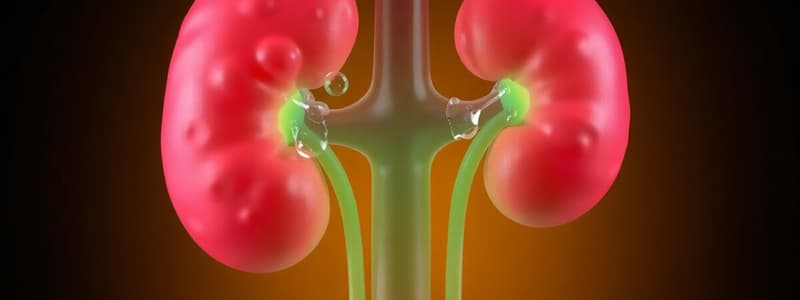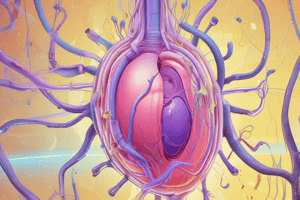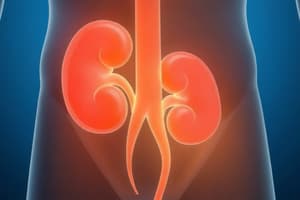Podcast
Questions and Answers
The primary function of urine production is to maintain homeostasis by regulating which two key aspects of blood?
The primary function of urine production is to maintain homeostasis by regulating which two key aspects of blood?
- Oxygen and glucose levels.
- Volume and composition. (correct)
- Temperature and viscosity.
- Pressure and pH.
Which metabolic waste is produced from the breakdown of amino acids in the liver?
Which metabolic waste is produced from the breakdown of amino acids in the liver?
- Urea. (correct)
- Creatinine.
- Uric acid.
- Ammonia.
Creatinine is a waste product resulting from the metabolism of what compound?
Creatinine is a waste product resulting from the metabolism of what compound?
- Urea.
- Amino Acids.
- Creatine phosphate. (correct)
- RNA molecules.
What process primarily occurs in the renal corpuscle?
What process primarily occurs in the renal corpuscle?
Which section of the nephron is characterized by the reabsorption of the majority of organic substrates?
Which section of the nephron is characterized by the reabsorption of the majority of organic substrates?
What is the primary role of the vasa recta?
What is the primary role of the vasa recta?
Which process involves the movement of solutes from the peritubular fluid into the tubular fluid?
Which process involves the movement of solutes from the peritubular fluid into the tubular fluid?
In which part of the nephron does ADH exert its influence to vary water reabsorption?
In which part of the nephron does ADH exert its influence to vary water reabsorption?
If a patient's urine osmolarity is consistently around 300 mOsm/L, what might this indicate?
If a patient's urine osmolarity is consistently around 300 mOsm/L, what might this indicate?
Which of the following is NOT typically reabsorbed in the proximal convoluted tubule?
Which of the following is NOT typically reabsorbed in the proximal convoluted tubule?
Which hormone directly influences sodium reabsorption in the distal convoluted tubule?
Which hormone directly influences sodium reabsorption in the distal convoluted tubule?
During filtration, what primarily determines which solutes enter the capsular space?
During filtration, what primarily determines which solutes enter the capsular space?
What would be the effect of increased ADH secretion on the collecting duct?
What would be the effect of increased ADH secretion on the collecting duct?
After reabsorption in the renal cortex, what vessels redistribute the water and solutes?
After reabsorption in the renal cortex, what vessels redistribute the water and solutes?
A patient is diagnosed with a condition that impairs the function of the nephron loop; what would be the most likely consequence?
A patient is diagnosed with a condition that impairs the function of the nephron loop; what would be the most likely consequence?
Which of the following is most likely secreted into the tubular fluid?
Which of the following is most likely secreted into the tubular fluid?
What substances are passively reabsorbed in the proximal convoluted tubule?
What substances are passively reabsorbed in the proximal convoluted tubule?
If the glomerular filtration rate (GFR) significantly decreases, what compensatory mechanism is likely to occur?
If the glomerular filtration rate (GFR) significantly decreases, what compensatory mechanism is likely to occur?
What is the outcome of blocking the action of aldosterone in the distal convoluted tubule?
What is the outcome of blocking the action of aldosterone in the distal convoluted tubule?
How much of the original filtrate is typically reabsorbed in the proximal convoluted tubules?
How much of the original filtrate is typically reabsorbed in the proximal convoluted tubules?
Flashcards
Urine production function
Urine production function
Maintaining homeostasis by regulating blood volume and composition, excreting metabolic wastes.
Urea
Urea
The most abundant metabolic waste, from amino acid breakdown in the liver.
Creatinine
Creatinine
Generated in skeletal muscle from creatine phosphate breakdown during muscle contraction.
Uric acid
Uric acid
Signup and view all the flashcards
Filtration in kidneys
Filtration in kidneys
Signup and view all the flashcards
Reabsorption
Reabsorption
Signup and view all the flashcards
Secretion
Secretion
Signup and view all the flashcards
Renal corpuscle function
Renal corpuscle function
Signup and view all the flashcards
Proximal convoluted tubule function
Proximal convoluted tubule function
Signup and view all the flashcards
Nephron loop function
Nephron loop function
Signup and view all the flashcards
Distal convoluted tubule function
Distal convoluted tubule function
Signup and view all the flashcards
Collecting system function
Collecting system function
Signup and view all the flashcards
Peritubular capillaries function
Peritubular capillaries function
Signup and view all the flashcards
Vasa recta function
Vasa recta function
Signup and view all the flashcards
Study Notes
- The primary function of urine production is to maintain homeostasis by regulating blood volume and composition.
- This process involves the excretion of metabolic wastes.
Metabolic Wastes
- Urea is the most abundant waste, a by-product of amino acid breakdown in the liver.
- Creatinine is generated in skeletal muscle tissue from creatine phosphate breakdown, crucial for muscle contraction.
- Uric acid is a waste formed during the recycling of nitrogenous bases of RNA molecules.
- The kidneys produce concentrated urine with an osmolality of 855–1335 mOsm/L, more than four times that of blood plasma.
- Osmolarity of urine is often reported as milliosmoles per kilogram of water (mOsm/kg H2O).
Urine Formation
- Filtration: Blood pressure forces water and solutes across glomerular capillaries into the capsular space.
- Only molecules small enough to pass through the filtration membrane are carried by water molecules.
- Reabsorption: Transport of water and solutes from the tubular fluid, across the tubular epithelium, and into the peritubular fluid.
- Secretion: Transport of solutes from the peritubular fluid, across the tubular epithelium, and into the tubular fluid.
Nephron Region Functions
- Renal corpuscle filters blood, generating approximately 180 L/day of filtrate.
- Filtrate composition is similar to blood plasma but without plasma proteins and blood cells.
- It filters water and both inorganic and organic solutes from plasma.
- It retains plasma proteins and blood cells.
Proximal Convoluted Tubules (PCT)
- Reabsorbs 60–70% of the water (108–116 L/day), 99–100% of organic substrates, and 60–70% of sodium and chloride ions in the original filtrate.
- Actively reabsorbs glucose, other simple sugars, amino acids, vitamins, and ions (including sodium, potassium, calcium, magnesium, phosphate, and bicarbonate).
- Passively reabsorbs urea, chloride ions, lipid-soluble materials, and water.
- Secretes hydrogen ions, ammonium ions, creatinine, drugs, and toxins
Nephron Loop
- Reabsorbs 25% of the water (45 L/day) and 20–25% of the sodium and chloride ions in the original filtrate; it creates the concentration gradient in the renal medulla.
- It reabsorbs sodium and chloride ions and water.
Distal Convoluted Tubules (DCT)
- Reabsorbs a variable amount of water (usually 5%, or 9 L/day) under antidiuretic hormone (ADH) stimulation.
- Reabsorbs a variable amount of sodium ions under aldosterone stimulation.
- Reabsorbs sodium and chloride ions, variable amounts of sodium and calcium ions, and water.
- Secretes hydrogen ions, ammonium ions, creatinine, drugs, and toxins.
Collecting System
- Reabsorbs a variable amount of water (usually 9.3%, or 16.8 L/day) under antidiuretic hormone stimulation.
- Reabsorbs a variable amount of sodium ions under aldosterone stimulation.
- Reabsorbs variable amounts of sodium and bicarbonate ions, and water.
- Secretes variable amounts of potassium and hydrogen ions.
Blood Vessels Functions
- Peritubular capillaries redistribute water and solutes reabsorbed in the renal cortex.
- They return water and solutes from the peritubular fluid to the general circulation.
Vasa Recta
- The vasa recta redistribute water and solutes reabsorbed in the renal medulla.
- They stabilize the concentration gradient of the renal medulla.
- They return water and solutes from the peritubular fluid to the general circulation.
Studying That Suits You
Use AI to generate personalized quizzes and flashcards to suit your learning preferences.





